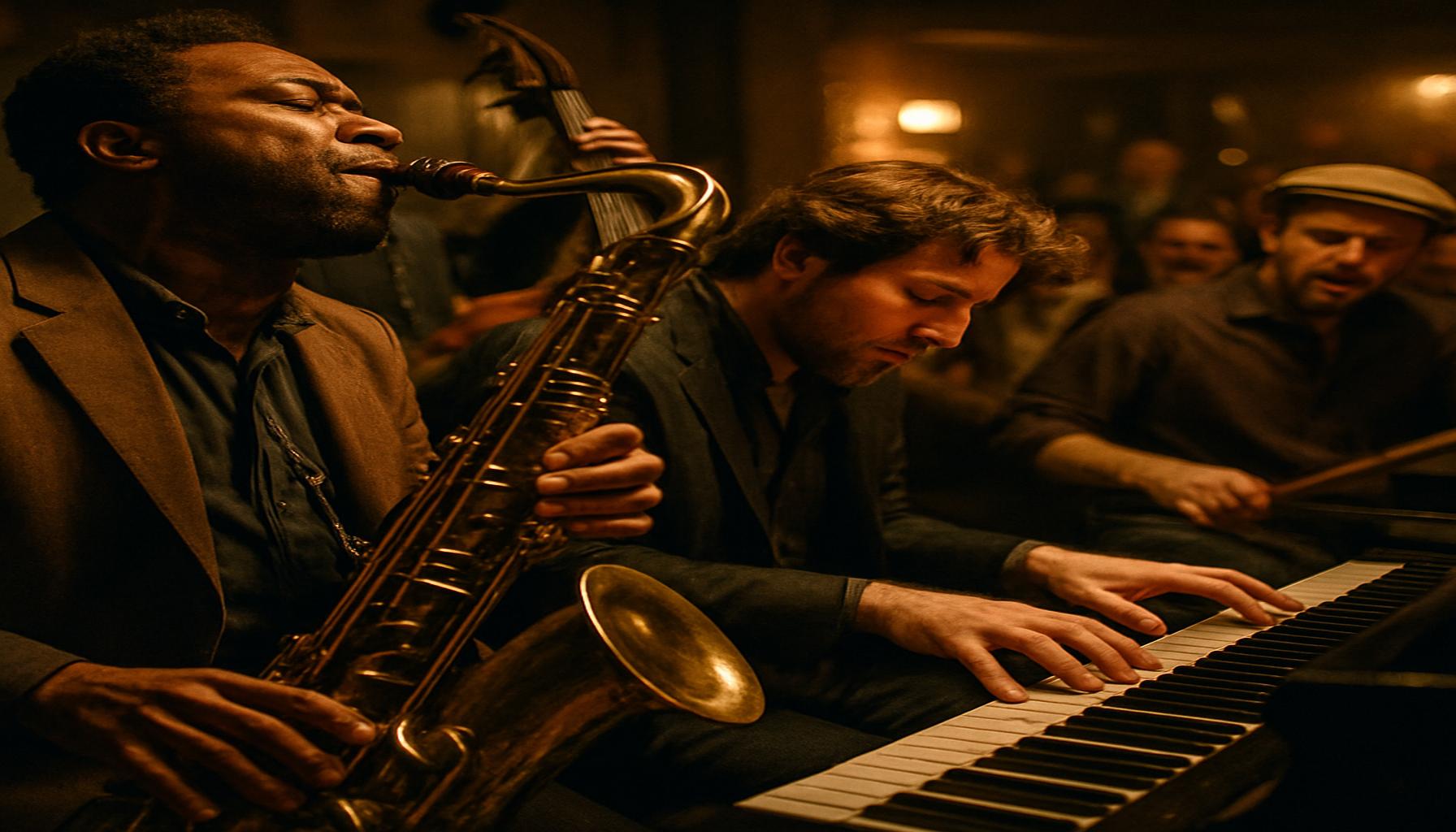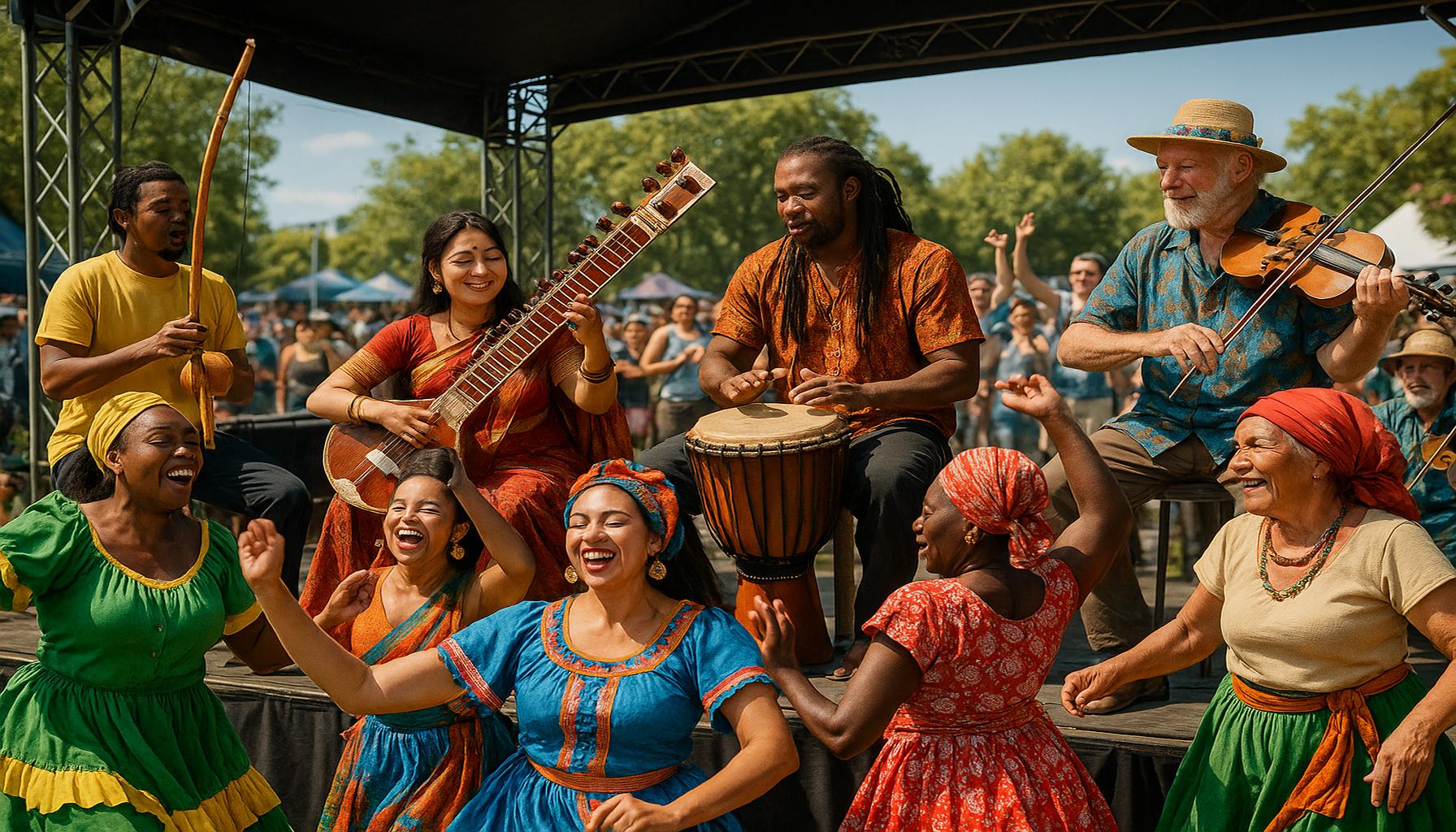Improvisation in Jazz: A Study on Creative Freedom and Musical Collaboration

Unleashing Creativity in Jazz
Jazz has long been celebrated not only for its rhythmic complexity and rich history but also for its unparalleled improvisation that lies at the heart of every performance. This music genre is a playground for artists where creative freedom flourishes, enabling musicians to break free from traditional structures and express their own unique voice. The result is a vibrant tapestry of sound that evolves with each performance, making every jazz event a distinctive experience.
Key elements of improvisation in jazz include:
- Spontaneity: Musicians craft melodies and harmonies in real-time, often shifting directions mid-piece. An exciting example is when a saxophonist explores a melody only to have the drummer respond with a syncopated rhythm, leading to an unexpected yet delightful musical detour.
- Interaction: The collaborative dialogue between players is much like a casual conversation. Consider how a trumpeter’s phrase might inspire a pianist to add an intricate chord progression, or how a bass line can ground a soloist while allowing their improvisation to soar creatively.
- Emotion: Performers channel their inner feelings through their instruments, translating personal experiences into musical phrases. For instance, a melancholy solo can evoke deep sentiment, resonating with listeners’ own experiences, as jazz often serves as both a personal and communal reflection.
Jazz legends like Miles Davis and Louis Armstrong are iconic figures who championed this improvisational spirit, demonstrating its power to elevate a simple melody into something truly remarkable. Their work is characterized by:
- Innovative solos: Miles Davis’s album “Kind of Blue,” for example, features improvisations that challenged conventional melodies, creating an iconic sound that still influences today’s artists.
- A deep understanding of musical structures: Both Davis and Armstrong utilized their mastery of scales and chords, allowing them to navigate through complex arrangements with unparalleled fluidity.
- A vibrant exchange of ideas: The cultural influences in their music, stemming from African American heritage, not only reflected their personal backgrounds but also enriched the entire genre, setting a precedent for future artists to draw upon.
Exploring the art of improvisation in jazz unveils an intricate balance between structured harmony and limitless creativity. As audiences around the world sit captivated by the spontaneous flows of sound, they witness a musical conversation that transcends time and place. With each performance, new layers of emotion and inspiration are unveiled, inviting listeners to delve deeper into the rich beauty of jazz.
So, step into the world of jazz, where the unexpected reigns, and discover the profound artistry that awaits within.

DISCOVER MORE: Click here to dive into the evolution of music
The Mechanics of Jazz Improvisation
At its core, jazz improvisation embodies a unique interplay between musician and instrument, a dance of creativity where notes and rhythms are molded in real-time. This interplay not only showcases individual talent but also highlights the importance of musical collaboration. Understanding the mechanics of improvisation helps to demystify this vital element of jazz and reveals its fundamental role in fostering creative expression.
Understanding Musical Elements
Improvisation in jazz operates through various musical elements that intertwine to create a cohesive sound. Each musician contributes their interpretations as they engage with harmonic structures and rhythmic patterns, leading to an extensive palette of possibilities. Some of the essential elements include:
- The Blues Scale: Central to jazz improvisation, the blues scale provides a framework for musicians to explore expressive melodies and emotive phrasing. Originating from African American traditions, this scale enables performers to convey deep feelings through their improvisations.
- Chord Progressions: Jazz often employs complex chord progressions that challenge musicians to navigate through shifts in harmony. The familiar ii-V-I progression is a staple in many jazz compositions and provides a launching point for improvisational creativity.
- Rhythmic Variability: The intricate rhythms of jazz allow for a wide spectrum of expression. Musicians frequently incorporate syncopation and polyr rhythms to reinforce the collaborative nature of their performance, keeping both the artists and the audience engaged and surprised.
Jazz musicians utilize these musical elements to craft personal narratives as they perform, effectively allowing the audience to experience an emotional journey. Take the legendary John Coltrane, for instance. His ability to fuse complex chords with emotive storytelling through the saxophone revolutionized jazz improvisation. Coltrane’s “A Love Supreme” showcases a seamless combination of emotional depth and intricate musical conversation, leaving a profound impact on listeners and musicians alike.
The Role of Collaboration in Jazz Improvisation
In jazz, collaboration is not merely about playing in a group; it represents a dynamic exchange of ideas and emotions among artists, fostering a collective creative experience. Musicians must listen intently to one another, responding and adapting their musical choices on the spot. This synergy leads to unforgettable moments where the magic of improvisation truly shines, exemplifying the collaborative spirit at the heart of jazz.
Examining the collaborative aspects can unveil the deep connections formed between musicians. When performers trust each other’s instincts, they can elevate the improvisation experience to new heights. This trust is beautifully illustrated when a guitarist plays a series of unexpected riffs, inspiring a trumpeter to counter with a bright, soaring melody, creating an exhilarating creative interplay.
In this way, jazz emerges as a forum for shared expression, where the fusion of diverse musical backgrounds fuels innovation. In the unfolding dialogue between musicians, the boundaries of individual performance expand, allowing them to create a truly immersive and unique soundscape. Every jazz performance stands as a collaborative masterpiece, echoing the vibrance of a continuously evolving genre.
| Advantages of Improvisation | Impact on Jazz Collaboration |
|---|---|
| Enhanced Creativity | Fosters an environment where musicians explore new ideas and innovate |
| Emotional Expression | Encourages personal storytelling through music, making each performance unique |
| Adaptability | Allows musicians to respond to each other’s cues, enhancing group synergy |
| Skill Development | Improvisation hones technical skills and musical knowledge through practice |
The exploration of improvisation in jazz reveals significant insights into how creative freedom enhances musical collaboration. Musicians thrive in an environment that promotes enhanced creativity, pushing them to innovate and delve into uncharted territories of sound. This freedom and spontaneity not only cultivate a vibrant atmosphere but also result in performances that can never be replicated. Moreover, emotional expression is integral to jazz, as musicians weave personal stories into their improvisations, rendering each performance a unique experience.Additionally, improvisation nurtures adaptability, drawing performers into a dynamic interaction where they respond intuitively to each other’s musical ideas. This synergy captures the essence of collaboration, as every note played influences the overall tapestry of the piece. Lastly, skill development is critical, as musicians continuously refine their technique and absorptive skills in this ever-evolving musical environment. The practice of improvisation not only enhances individual capabilities but advances the collective artistry of jazz musicians as a whole.
DISCOVER MORE: Click here to learn about the evolution of digital art
The Impact of Jazz Standards on Improvisation
Jazz standards hold a pivotal position in the world of jazz improvisation, serving as a foundation upon which musicians build their creative expressions. These well-known compositions, ranging from classics like “All the Things You Are” to “Autumn Leaves,” provide a familiar framework that allows artists to explore uncharted waters of innovation. Musicians can interpret these pieces in countless ways, enriching the performance through improvisational techniques while engaging in a shared musical vocabulary.
Exploration of Form and Structure
The structure of jazz standards provides a unique opportunity for musicians to experiment. Typically characterized by clear phrases, chord changes, and rhythmic patterns, these forms serve as launching pads for improvisation. By mastering the nuances of a standard, jazz musicians learn to navigate its harmonic landscape, enabling them to depart from the original theme and inject their interpretations.
This exploration can take many shapes, as seen in iconic performances. For instance, saxophonist Sonny Rollins is renowned for his improvisational brilliance on the standard “St. Thomas.” Rollins frequently distorts, and reinterprets the melody, weaving personal anecdotes into his performance, which creates an exhilarating experience for listeners. Such an approach not only showcases his technical prowess but also encapsulates the very essence of stylistic freedom that lies within jazz.
The Influence of Genre-Blending
As jazz has evolved, so too have the influences that shape its improvisation. The incorporation of elements from other genres—such as rock, funk, blues, and classical—has fostered a rich tapestry of musical collaboration. Artists are increasingly encouraged to draw from diverse sources, allowing them to redefine the boundaries of jazz improvisation. This genre-blending serves as a reflection of the modern world, where cultures and styles continuously interact and influence each other.
For instance, trumpeter Wynton Marsalis skillfully combines traditional jazz with classical influences, creating a dynamically varied sound. His work often highlights collaborative elements, as he integrates classical musicians into jazz ensembles, bridging the divide between genres. This means that improvisation, while rooted in jazz traditions, can also resonate with a broader audience, appealing to both jazz aficionados and fans of other musical styles.
Technology and Modern Innovation
The rapid advancement of technology has further transformed the jazz improvisation landscape. Digital platforms, such as streaming services and social media, enable musicians to connect, collaborate, and share their improvisations with wider audiences. Access to a wealth of recorded performances allows upcoming musicians to study and learn from the masters, encouraging ongoing evolution within the genre.
Furthermore, innovative tools such as loop pedals and electronic instruments lend musicians new avenues to experiment and express their creativity. The use of these modern techniques is evident in the work of contemporary artists like Esperanza Spalding, who utilizes technology to layer her bass lines and vocals during live performances, creating a stunning tapestry of sound that challenges traditional norms of jazz improvisation.
In summary, jazz improvisation thrives within the context of standards, genre-blending, and technological advancements, creating a vibrant environment for musical collaboration. This multifaceted fabric enriches the genre while allowing for infinite possibilities of creative expression, as musicians continue to push the limits of what jazz can be—one note at a time.
DISCOVER: Click here to learn more about the impact of music on mental health
Conclusion: The Ever-Evolving Landscape of Jazz Improvisation
In conclusion, the world of jazz improvisation stands as a testament to the power of creative freedom and musical collaboration. The significance of jazz standards in providing a launchpad for improvisation cannot be overstated; they offer musicians a structured space to explore their individual voices while fostering a sense of unity through shared experience. As artists like Sonny Rollins and Wynton Marsalis exemplify, exploring the boundaries of musical genres opens new avenues for innovation, breathing new life into traditional forms.
The seamless integration of technology further accentuates the dynamism of jazz improvisation, enabling contemporary artists to push beyond conventional limits. Tools such as loop pedals and digital platforms have transformed how artists connect with audiences and each other, thereby democratizing the creation of music and ensuring that the genre remains relevant in an ever-changing cultural landscape. In a society where diversity thrives, the genre-blending characteristic of jazz reflects a broader cultural exchange, allowing musicians to draw inspiration from varied influences and experiences.
As we move forward, the ongoing evolution within jazz improvisation invites listeners to engage with the music more deeply, encouraging them to appreciate the limitless potential of creativity. This exploration fosters an environment where artists continually redefine what jazz can be—each note a reflection of personal narrative and shared history. Thus, the essence of jazz improvisation lies not just in the music itself but in the open dialogue it creates among musicians and fans alike, inviting all to join in on a collective journey of discovery.


